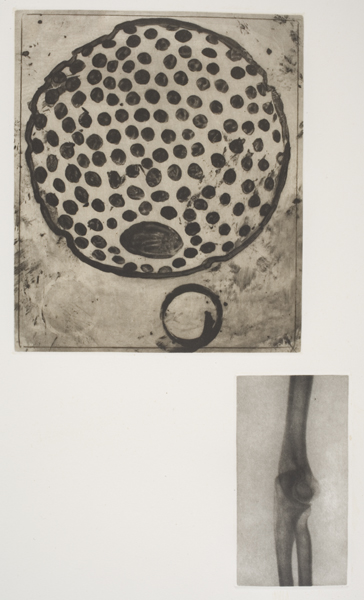Fourteen Etchings 8 and Fourteen Etchings 13

The above prints by Terry Winters (b. 1949) unite themes of natural history, poetry, language, art and science. From a portfolio titledFourteen Etchings, the prints were originally intended to directly illustrate Eureka, Edgar Allan Poe’s prose poem on the uncertain relationship between the universe, man and science. Winters’ original intention for the portfolio was later revised with his discovery of a list of major constellations in Roget’s International Thesaurus. Each print in the portfolio displays two disparate images: one is that of the artist’s drawings on Mylar that evoke macroscopic celestial forms to microscopic primordial cell-like forms; while the second image, a kind of a memento mori, features photos from a nineteenth century anatomical text by Wilhelm Röntgen (1845-1923), the first scientist to record X-rays. The drawing is etched through aquatint, while the photographic image was transferred through photogravure. The result is an interplay between the photographic and hand-drawn methods of image making, reflecting Winters’ aesthetic attraction to process.
The consistent grisaille tonal range and the cropping of images prompt a tense juxtaposition between science and art, figuration and abstraction, the macrocosmic and the microcosmic, and artistic ingenuity and postmodernist proclivity for appropriation. This interaction of seemingly unrelated images is found in other art historical precedents such as in Rauschenberg’s photo poetics that amalgamated seemingly disparate images to create poetic expressions. Still, this dichotomy may be seen to unite the microscopic to the human to the celestial in the spirit of systematic documentation and analytical classification, transforming the portfolio into a form of natural history: “a collection of portraits of related spherical shapes.” The prints thus fall under the canopy of the nineteenth century conception of natural history as a combination of visual images and implied language—the latter offered through Winters’ original intention for the portfolio. Although Natural history itself was seen to offer simultaneous “designation and derivation,” the images in Winters’ prints constantly oscillate between visual identification, and constant transmutation of subject matter—the anatomical photos and the volvox motifs do not easily impose identification or yield stable common elements. Thus, it may be suggested that to a certain degree, this portfolio seeks to expose that shortcomings of nineteenth century sciences, a theme that is also echoed in Poe’s Eureka.
Consequently, it may be suggested that although Winters reshaped the project, by eschewing direct and literal depictions of Eureka, Winters’ may have remained conceptually and spiritually close to Poe’s prose poem by echoing certain recurring themes. As a result, the prints offer open-ended interpretations, allowing viewers to invent their own identifications, designations, associations, and interpretations of a moment where the birth and the death of the universe, science, art and man converge into one.
Cabelle Ahn ’12
Curatorial Intern, Summer 2011